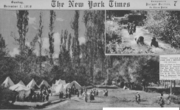- Armenian casualties during World War I
-
Armenian Genocide BackgroundArmenians in the Ottoman Empire · Armenian Question · "Hamidian" (1894–96) · Zeitun (1895–96) · Ottoman Bank (1896) · Yıldız (1905) · Adana (1909) · Young Turk Revolution (1908)The GenocideCongress at Erzurum · Red Sunday · Tehcir Law · Labour battalions
Trials:
Deportation:
Centres: All the settlements at Western Armenia
Camps:Deir ez-Zor · Ra's al-'Ayn
Foreign aid and relief:ACRNE · NARC
Resistance:
Zeitun · Van · Musa Dagh · Urfa · Shabin-Karahisar
Responsible parties:
Young Turks: Committee of Union and Progress (Talaat · Enver · Djemal · Behaeddin Shakir) · Special Organization · (Reshid · Djevdet · Topal Osman)
Kurdish Irregulars
Courts-Martial · Malta Tribunals · Soghomon TehlirianArmenian populationSee alsoArmenian casualties during World War I covers the Armenian casualties beginning with 1914 to 1922 when the Democratic Republic of Armenia becomes part of Armenian Soviet Socialist Republic. There is no direct estimate on how many Armenians lived before 1914. The main causes can be classified as:
Contents
Deportations
Main article: Armenian casualties of deportationsSee also: Tehcir LawDifferent sources gives different numbers. Bayur wrote: "800,000 Armenians died as a result of deportations or died in labor brigades."[1] Yusuf Halacoglu an estimates that 40 thousand casualties had been registered during relocation which he claims only half a million Armenians were effected.[2]
Famine
The statistics published by the near-east relief comes under Democratic Republic of Armenia. The government of Hovhannes Kachaznuni, was responsible for over half a million Armenian refugees in the Caucasus.[3] A report in early 1919 noted that the lives had been claimed of: 65% of the population of Sardarabad, 40% of the population of eight villages near Etchmiadzin, 25% of the population of Ashtarak, and this continues... The 393,700 Ottoman refugees were under their jurisdiction as follows:[3]
District Erivan Ashtarak Akhta-Elenovka Bash-Grani Novo-Bayazit Daralagiaz Bash-Abaran Etchmiadzin Karakilisa Dilijan Number of refugees 75,000 30,000 22,000 15,000 38,000 36,000 35,000 70,000 16,000 13,000 Another source to the fate of half a million Armenian refugees of the government of Hovhannes Kachaznuni, comes from League of Nations study published in 1926[4] and individual report of "Transfer of Armenian Refugees to the Caucasus and Creation of an Armenian National Home in That Region".[5] The refugees under Democratic Republic of Armenia, which was in transition to Armenian SSR at that time, was listed as 400,000 to 420,000 of Ottoman Armenian survivors after the war.[6]
Sickness
See also: Spanish Flu PandemicThere is no published statistics for the number of people who died within the camps of red cross and American Committee for Relief in the Near East.
 Near East Relief Workers in Sivas
Near East Relief Workers in Sivas
Armed conflicts
See also: Democratic Republic of ArmeniaDemocratic Republic of Armenia which was established in 1918, was the first Armenian Republic. Conditions in the resistance of March 1918 was best explained by R.G. Hovannisian: "In the summer of 1918 the Armenian National council reluctantly transferred from Tiflis to Yerevan to take over the leadership of the republic from the popular dictator Aram Manukian and the renowned military commander Drastamat Kanayan. It then began the daunting process of establishing a national administrative machinery in an isolated and landlocked misery. This was not the autonomy or independence of which Armenian intellectuals had dreamed and for which a generation of youth had been sacrificed".[7] There were low value to ten thousands to high value hundred thousand Armenians were perished during the military conflicts of World War I, beginning with the Armenian Resistance and following years under many campaigns of DRA. DRA was in military conflicts in the Battle of Kara Killisse (1918), the Battle of Sardarapat, and Battle of Bash Abaran with the Ottoman Empire. Also, Georgian-Armenian War 1918, Armenian-Azeri war 1918, and later Turkish-Armenian War. During the 1914-18 Armenian military power against the Ottoman Empire had an historical record. The total number of Armenian volunteer units was in 150,000, according to Boghos Nubar, the president of the "Armenian National Delegation":
In the Caucasus, where, without mentioning the 150,000 Armenians in the Imperial Russian Army, more than 40,000 of their volunteers contributed to the liberation of a portion of the Armenian vilayets, and where, under the command of their leaders, Antranik and Nazerbekoff, they, alone among the peoples of the Caucasus, offered resistance to the Turkish armies, from the beginning of the Bolshevist withdrawal right up to the signing of an armistice."[8]The total death of Armenians (KIA, WIA, etc) because of the military activity of the Armenian volunteer units and Armenian Militia, which joined the military force of Democratic Republic of Armenia is unpublished by successor state Armenia.
See also
- Armenian Genocide
- Ottoman Armenia
- Ottoman Armenian population
- Turkish War of Independence
Notes
- ^ Yusuf Hikmet Bayur, Türk Inkilabi Tarihi, Vol. III, Sec. IV, p. 787
- ^ Halacoglu, Prof. Dr. Yusuf, Ermeni Tehcirine Ait Gercekler (1915), TTK Publication, Ankara, 2001.
- ^ a b The Republic of Armenia, Hovannisian, R.G.
- ^ See: League of Nations: Assembly: Fifth Committee published reports: Armenian and Russian Refugee Problems; Report... Geneva: np, 1926.
- ^ "Transfer of Armenian Refugees to the Caucasus and Creation of an Armenian National Home in That Region; Report... Geneva: np, 1924.
- ^ See: League of Nations: Assembly: Fifth Committee published reports: Armenian and Russian Refugee Problems; Report... Geneva: np, 1926. Settlement of Armenian Refugees; Report... Geneva: Imprimerie Kundig, 1926. Transfer of Armenian Refugees to the Caucasus and Creation of an Armenian National Home in That Region; Report... Geneva: np, 1924.
- ^ "The Armenians: Past and Present in the Making of National Identity" p.98, edited by Edmund Herzig, Marina Kurkchiyan
- ^ letter to French Foreign Office - December 3, 1918
Categories:- Ottoman Empire in World War I
- Armenian Genocide
- History of the Ottoman Empire
- Demographics of the Ottoman Empire
- 20th century in Armenia
Wikimedia Foundation. 2010.
